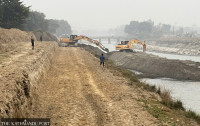National
Encroachment shrinking bio corridors
The biological corridors used by wildlife to travel freely between the protected areas in Nepal and India are shrinking due to encroachment, in some cases causing a complete halt in the animal movement.
DR Panta
The biological corridors used by wildlife to travel freely between the protected areas in Nepal and India are shrinking due to encroachment, in some cases causing a complete halt in the animal movement.
The routes used by wild elephants and tigers for centuries, including the one joining Dudhuwa National Park in India and Mohana-Laljhadi corridor in Nepal, have been encroached for years. This situation, conservationists say, was invited by the government’s lack of plan to resettle the communities living near protected forest areas.
Mohana-Laljhadi biological corridor covers 24,664 hectares of forest land that extends up to 90 kilometres between Kailali and Kanchanpur districts.
The major parts of the corridor passes through three human settlements in Dekhatbhuli and Doke bazaar, according to Bir Bahadur Thagunna, the assistant district forest officer of Kanchanpur.
“We don’t have exact data on how much forest cover has been encroached along with the biological corridor. But there are at least three human settlements directly interfering the wildlife movement,” Thagunna said.
Although the government has launched a programme to protect Mohana-Laljhadi corridor, it has not been implementation effectively.
Prakash Lamsal, the under secretary at the Department of Forests, says many traditional corridors used by wildlife for movement and habitats in the Far West and Chure regions are under serious encroachment threat.
“Biological corridors play an important role in improving and strengthening connectivity among protected areas,” Lamsal said, referring to the works done by the Indian authorities in managing the Khata corridor that links India’s Katarniaghat Wildlife Sanctuary with Nepal’s Bardiya National Park.
Ramesh Chand Thakuri, the acting director general of Far-Western Regional Forest Directorate, says there is a widening gap between important wildlife corridors joining Nepal and India’s protected areas.
While some communities have been living inside forests for decades, new settlements are also cropping up. “The new human settlements are not only disturbing the wildlife movement, it is also increasing the incidents of human and wildlife conflict,” Thakuri said. “Around 17 percent of the total forestland covered by the traditional biological corridors in Kailali and Kanchanpur have been encroached to accommodate human settlements.”
Raj Bahadur Aire of Community Forest Coordination Committee in Kailali says the locals can play an instrumental role in wildlife and forest protection efforts if the government and other concerned authorities come up with a proper resettlement programme.




 16.12°C Kathmandu
16.12°C Kathmandu















